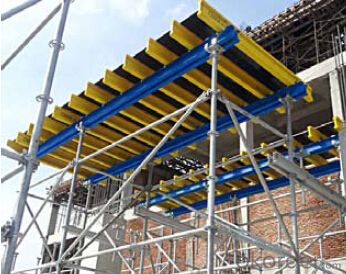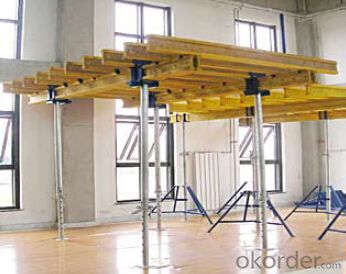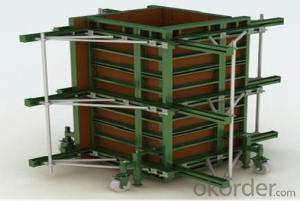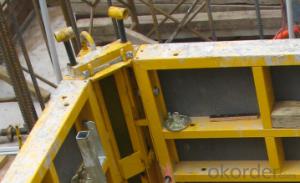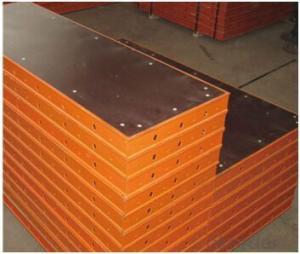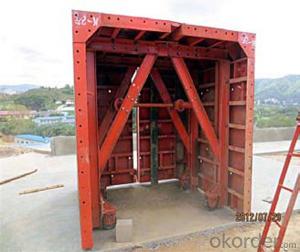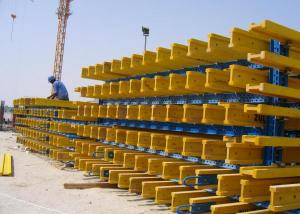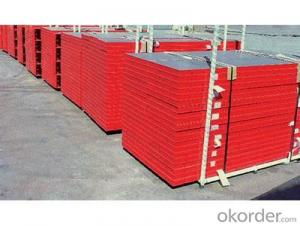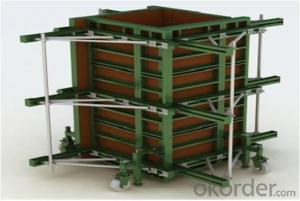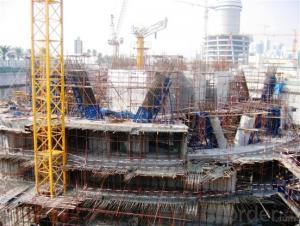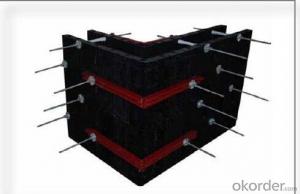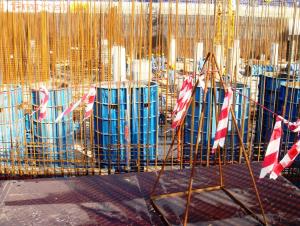Table Formwork System
- Loading Port:
- China Main Port
- Payment Terms:
- TT OR LC
- Min Order Qty:
- -
- Supply Capability:
- -
OKorder Service Pledge
OKorder Financial Service
You Might Also Like
Tabel Formwork:
Table formwork is the most typical application for slab, with timber beam, the slab formwork is
light weight, fast and economic in the construction.
Characteristics:
◆ Simple structure, easy assembly.
◆ Flexible structure, be adapted to different support system.
◆ High construction efficiency with special system tools.
1. Lifting fork for lifting the table formwork to upper floor.
2. Trolley for moving the table formwork on floor.
◆ Flexible application with stand alone props.
◆ Safer condition with handrails.
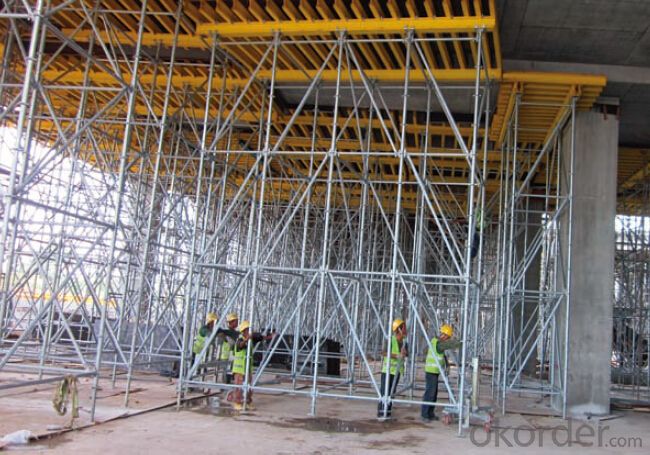
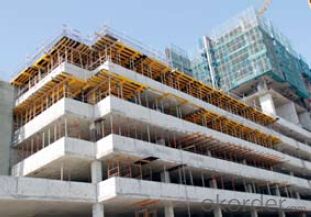
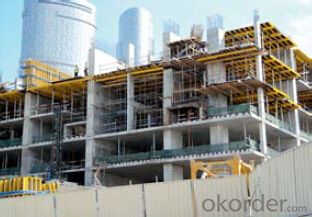
- Q: What safety measures should be taken when using steel frame formwork?
- When using steel frame formwork, it is important to take several safety measures to ensure the well-being of workers and prevent any potential accidents or injuries. Here are some key safety precautions that should be taken: 1. Personal Protective Equipment (PPE): All workers should wear appropriate PPE such as hard hats, safety goggles, gloves, and steel-toed boots. This will provide protection against potential hazards, including falling objects and sharp edges. 2. Training and Competency: Workers should be adequately trained and competent in using the steel frame formwork system. This includes understanding its assembly, dismantling, and usage procedures. Training should also cover safe handling techniques, load limits, and the correct use of tools and equipment. 3. Inspection and Maintenance: Regular inspection and maintenance of the steel frame formwork is crucial to identify any defects or damage that can compromise its structural integrity. This includes checking for cracks, rust, misalignments, loose or missing components, and any signs of wear and tear. Damaged or faulty parts should be repaired or replaced promptly. 4. Proper Assembly and Dismantling: Following the manufacturer's instructions and guidelines, the steel frame formwork should be correctly assembled and dismantled. This should be done by experienced and trained personnel to ensure stability and prevent accidents. Adequate bracing and support should be used during assembly to avoid collapse or movement. 5. Secure Fixing: The steel frame formwork should be securely fixed to the structure using appropriate clamps, bolts, or other fastening mechanisms. This will prevent any movement or displacement during concrete pouring or other construction activities. 6. Load Limits: It is crucial to adhere to the load limits specified by the manufacturer. Overloading the steel frame formwork can lead to structural failures or collapse. Therefore, the weight of the concrete, construction materials, and workers should be carefully calculated and monitored to avoid exceeding the maximum load capacity. 7. Fall Protection: Adequate fall protection systems, such as guardrails, safety nets, or personal fall arrest systems, should be in place to prevent falls from heights. This is particularly important when workers are working on elevated platforms or platforms with openings. 8. Communication and Coordination: Clear communication and coordination between workers are essential to ensure a safe working environment. This includes providing instructions, warnings, and signals to avoid accidents and promote a smooth workflow. By following these safety measures, the risk of accidents, injuries, and structural failures can be significantly reduced when using steel frame formwork. It is crucial to prioritize safety and provide ongoing training and supervision to all personnel involved in the construction process.
- Q: Are there any safety precautions to consider when using steel frame formwork?
- Several safety precautions need to be considered when using steel frame formwork. To begin with, it is essential to ensure the proper assembly and secure fastening of the steel frame formwork before use. This will help prevent any potential collapses or accidents during the construction process. Regular inspections should also be carried out to detect any signs of damage or wear, and any compromised components should be promptly repaired or replaced. Furthermore, workers must undergo comprehensive training on the safe handling and use of the steel frame formwork. This includes understanding the correct techniques for lifting and placing the formwork, as well as being aware of the maximum load capacity of the system. Exceeding the recommended load limits should be strictly avoided to prevent structural failures or accidents. Additionally, it is crucial to wear appropriate personal protective equipment (PPE) at all times when working with steel frame formwork. This includes safety helmets, protective eyewear, gloves, and non-slip footwear. In situations where working at heights or in potentially hazardous conditions, the use of harnesses and fall protection systems may be necessary. Lastly, it is of utmost importance to adhere to all relevant safety regulations and guidelines when using steel frame formwork. This involves complying with local building codes, ensuring proper bracing and shoring, and having emergency plans in place in case of accidents or emergencies. By following these safety precautions, the risk of accidents and injuries can be minimized when utilizing steel frame formwork in construction projects.
- Q: What are the different types of formwork corners used in steel frame formwork systems?
- Steel frame formwork systems commonly utilize various types of formwork corners to ensure stability and support for the formwork structure. These corners are crucial for proper pouring and curing of concrete. 1. External corners enable the creation of 90-degree angles on the formwork's external surfaces. Typically constructed from durable steel or aluminum, they offer strength and longevity. Additionally, external corners allow for adjustable configurations, providing flexibility in formwork design. 2. Internal corners, similar to their external counterparts, facilitate the formation of 90-degree angles. Constructed from steel or aluminum, they can also be adjusted to fit the desired formwork shape. Internal corners are indispensable for achieving precise and accurate formwork structures. 3. Column corners are specifically designed for formwork around columns or pillars. Their shape conforms to the curvature of the column, delivering support and stability to the formwork structure. Various sizes of column corners are available to accommodate different column diameters. 4. Wall corners are utilized to create corners in formwork structures that deviate from 90-degree angles. These corners are typically adjustable, allowing for flexibility in formwork design. They are purposefully designed to provide stability and support in non-standard corner angles. 5. Beam corners are essential for formwork structures involving beams. They are designed to offer stability and support while accommodating the specific shape and dimensions of the beams. Beam corners are available in various sizes to accommodate different beam dimensions. Ultimately, the diverse range of formwork corners in steel frame formwork systems ensures the integrity of the concrete formwork, enabling accurate and secure concrete pouring.
- Q: What are the different types of finishes that can be achieved using steel frame formwork?
- There are several types of finishes that can be achieved using steel frame formwork in construction projects. 1. Smooth Finish: Steel frame formwork allows for a smooth finish on concrete surfaces. The steel formwork panels are designed to provide a flat and even surface, resulting in a smooth finish on the concrete once it is poured and set. 2. Textured Finish: Steel formwork can also be used to create textured finishes on concrete surfaces. This can be achieved by using pre-designed steel formwork panels that have patterns or textures imprinted on them. When the concrete is poured into these formwork panels, it takes on the texture of the panel, resulting in a textured finish. 3. Exposed Aggregate Finish: Steel frame formwork can be used to achieve an exposed aggregate finish on concrete surfaces. This is done by using formwork panels that have a rough or textured surface. When the concrete is poured into these panels, the top layer is removed to expose the aggregate underneath, creating a visually appealing and textured finish. 4. Stamped Finish: Steel formwork can also be used to create stamped finishes on concrete surfaces. This is done by using specially designed formwork panels that have patterns or designs imprinted on them. When the concrete is poured into these panels, the patterns are transferred onto the surface of the concrete, resulting in a stamped finish. 5. Architectural Finish: Steel frame formwork can be used to achieve various architectural finishes on concrete surfaces. This includes finishes such as ribbed, fluted, or curved surfaces. The flexibility of steel formwork allows for the creation of unique and intricate architectural designs and finishes. In summary, steel frame formwork offers a wide range of finishes that can be achieved on concrete surfaces, including smooth, textured, exposed aggregate, stamped, and architectural finishes. These finishes provide aesthetic appeal and enhance the overall look of the construction project.
- Q: Can steel frame formwork be used for curved or irregular shapes?
- Indeed, curved or irregular shapes can be constructed using steel frame formwork. Unlike conventional timber formwork, steel frame formwork offers greater flexibility and adaptability to accommodate diverse shapes and designs. The steel frames can be effortlessly bent or adjusted to achieve the desired curvature, facilitating the construction of curved or irregular structures. Moreover, the steel frames guarantee a robust and long-lasting support system, guaranteeing the stability and integrity of the formwork throughout the construction process. Consequently, steel frame formwork emerges as the optimal choice for projects involving curved or irregular shapes.
- Q: How does steel frame formwork help in reducing on-site material storage?
- The utilization of steel frame formwork aids in the reduction of on-site material storage by offering a reusable and efficient system for construction projects. This particular formwork entails the use of pre-fabricated steel panels that can be easily assembled and disassembled. In contrast to conventional timber formwork, steel frame formwork does not necessitate the allocation of ample storage space for large quantities of timber boards, plywood, or other materials. The steel panels can be compactly stacked and stored when not in use, resulting in substantial space savings on the construction site. Moreover, steel frame formwork is specifically designed for multiple reuses, thus diminishing the requirement for additional materials. The durability and strength of steel allow for the repeated employment of the formwork panels without compromising their structural integrity. Consequently, there is no constant need for material replenishment, thereby reducing the on-site waste generation. Additionally, steel frame formwork exhibits high adaptability and can be effortlessly adjusted to accommodate various shapes and sizes of concrete structures. This versatility eliminates the necessity for custom-made formwork and minimizes the storage demands for different formwork configurations. In conclusion, the utilization of steel frame formwork contributes to the reduction of on-site material storage by providing a reusable and space-efficient system that obviates the need for extensive storage space for traditional timber formwork materials. Its durability and adaptability further enhance construction efficiency and minimize waste generation.
- Q: Can steel frame formwork be used for both conventional and lightweight concrete?
- Yes, steel frame formwork can be used for both conventional and lightweight concrete. The strong and durable nature of steel makes it suitable for various types of concrete, providing stability and support during the pouring and curing process.
- Q: How does steel frame formwork impact the overall constructability of a project?
- Steel frame formwork can have a significant impact on the overall constructability of a project in several ways. Firstly, steel frame formwork provides a sturdy and reliable support structure for concrete during the construction process. This ensures that the concrete is poured and cured properly, resulting in a stronger and more durable final structure. Additionally, steel frame formwork allows for faster construction compared to traditional formwork methods. The pre-fabricated steel panels can be easily assembled and disassembled, reducing the overall construction time and increasing productivity on the site. This is particularly beneficial in projects with tight schedules or where time is of the essence. Furthermore, steel frame formwork offers flexibility and adaptability in terms of design changes. The panels can be easily adjusted to accommodate any modifications or alterations in the construction plans. This saves time and resources that would have otherwise been spent on demolishing and rebuilding formwork. Moreover, steel frame formwork contributes to a safer working environment. The steel panels are designed to withstand heavy loads and provide stability, reducing the risk of accidents and injuries on the construction site. This not only ensures the well-being of the workers but also minimizes project delays caused by safety issues. Lastly, steel frame formwork is highly durable and reusable, making it a cost-effective solution for multiple projects. The robustness of the steel panels allows them to be used repeatedly, reducing the need for constant replacement and saving construction costs in the long run. In conclusion, steel frame formwork positively impacts the overall constructability of a project by providing strength, speed, flexibility, safety, and cost-effectiveness. Its ability to support concrete and facilitate faster construction makes it an essential component in modern construction practices.
- Q: How does steel frame formwork affect the quality of the finished concrete surface?
- Steel frame formwork can have a positive impact on the quality of the finished concrete surface. The rigid structure of steel frame formwork provides stability during the pouring and curing process, ensuring that the concrete maintains its desired shape and alignment. This prevents any potential deformities or unevenness in the surface. Additionally, the smooth surface of the steel frame formwork helps in achieving a smooth and uniform finish on the concrete, resulting in a high-quality final product.
- Q: Can steel frame formwork be reused?
- Yes, steel frame formwork can be reused. Steel is a durable and long-lasting material, making it suitable for multiple construction projects. The formwork can be disassembled, cleaned, and reassembled for future use, reducing the need for new formwork and saving costs in the long run.
Send your message to us
Table Formwork System
- Loading Port:
- China Main Port
- Payment Terms:
- TT OR LC
- Min Order Qty:
- -
- Supply Capability:
- -
OKorder Service Pledge
OKorder Financial Service
Similar products
Hot products
Hot Searches
Related keywords


